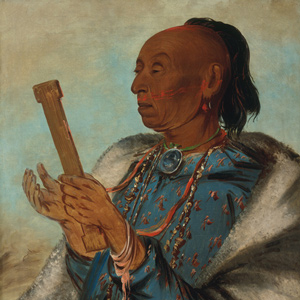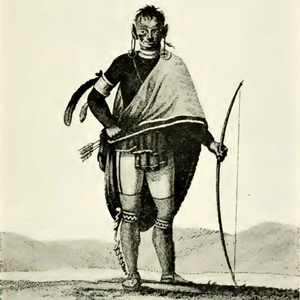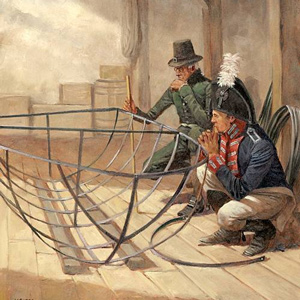The Lewis and Clark Expedition ostensibly began in February 1801 when President Thomas Jefferson wrote a letter to Army commander General James Wilkinson requesting that Lieutenant Meriwether Lewis become the President’s personal secretary. Exploration of North America’s western half had long been a goal of the president, and now he had a young protégé who might lead such an expedition.
On 18 January 1803, Lewis hand-delivers to the U.S. Congress the President’s request to fund what would become known as the Lewis and Clark Expedition. The President works in Washington City and Monticello to craft instructions and line up the best talent to assist Lewis. In France, three diplomats negotiate with Napoleon Bonaparte to purchase the Louisiana Territory.
Meriwether receives training, supplies and equipment in Philadelphia and avails himself of armaments and specialized equipment—including a collapsable iron-framed boat—at the Schuylkill and Harpers Ferry arsenals. By July 1803, everything is at Fort Fayette in Pittsburgh. All Lewis needs is a large boat to carry everything down the Ohio. He also needs to know if William Clark will accept his invitation to join him.
In-depth Articles
The Kickapoos
Always on the move
by Kristopher K. Townsend
Perhaps more than any North American people, the Kickapoo exemplify the transitory nature of the native nations encountered during the Lewis and Clark Expedition. In 1803, there was at least one village near Ste. Genevieve on the Mississippi River.
The Shawnees
by Kristopher K. Townsend
As soon as the expedition boats arrived at the Mississippi River, the captains began counting Shawnee people. The Estimate of the Eastern Indians reports that 600 “Shawonies” were living on the “apple River near Cape Gerardeau.”
The President’s Secretary
by Arlen J. Large
It was 4 March 1801, Inauguration Day for the third president. Nine days previously Jefferson had asked Meriwether Lewis to serve as his private secretary in the raw new mansion called the President’s House.
Jefferson’s Monticello
Source and paradigm
by Joseph A. Mussulman
After some eight months of planning and discussion, President Thomas Jefferson handed his twenty-eight-year-old secretary, Captain Meriwether Lewis, a letter containing instructions for the conduct of one of the most significant undertakings in American history.
Lewis’s Report on Army Officers
The 1802 Army's Reduction in Force
by Stephen S. Witte
In his capacity as the President’s secretary, Meriwether Lewis prepared a report in which he classified the Army’s officers by military merit and by political affiliation, if known. Both of these factors were considered in identifying candidates for dismissal.
Lewis’s Estimate of Expenses
by Kristopher K. Townsend
Prior to Jefferson’s annual message to Congress on 15 December 1802, Lewis prepared a roughly itemized estimate of $2500 as the cost of the expedition.
Synopsis Part 1
Washington City to Fort Mandan
by Harry W. Fritz
The Corps of Discovery, as it would be called, or the “corps of volunteers for North Western Discovery,” as Lewis put it, epitomized the rising glory of the United States—its sense of limitless possibilities and unparalleled opportunities.
The Louisiana Purchase
by Pierce Mullen
Easter week in Paris, 1803, was truly momentous for the young United States of America. The American Minister to France, Robert R. Livingston was sent to discuss the difficult question of New Orleans, the Mississippi and Franco-American relations.
Jefferson’s Secrecy
Lewis and Clark under cover
by Arlen J. Large
During the planning and preparations for the Western Expedition, Thomas Jefferson practiced selective levels of secrecy.
Lewis and the Board of Agriculture
by Arlen J. Large
As the President’s private secretary, the 28-year-old Army captain wasn’t in the same league with the political heavy-weights on the new American Board of Agriculture.
Early American Flags
by Joseph A. Mussulman
Lewis’s long list of needs for the journey would have been a large supply of American flags, to be flown on their boats, over their camps, and at their council sites. Leading up to the Lewis and Clark expedition, what did the young country’s flags look like?
Eastern Travels
Washington City to Pittsburgh
by Lorna Hainesworth
Lewis’s letters reveal a fastidious quartermaster, a meticulous project director, an exceptional logistics manager and a superb bureaucrat who was scrupulously devoted to detail. Lorna Hainesworth unravels the eastern travels of Meriwether Lewis between March and July 1803 using a letter that she uncovered in 2009.
Harpers Ferry by Air
Wedge of history
by Joseph A. Mussulman
Harpers Ferry’s tiny footprint belies the richness of its roles in American history—in industrialization, in commerce, and especially in the unfolding of the Civil War and the long struggle of African-Americans out of slavery.
Harpers Ferry
U.S. Armory and Arsenal
by Joseph D. Jeffrey
During preparations, Lewis relied on the Harpers Ferry Armory and Arsenal for the guns and hardware that would meet his unique requirements.
Shipping the Supplies
Quartermaster Lewis
by Frank Muhly, Joseph A. Mussulman
Considering all he had to do to prepare for the expedition, Lewis was fortunate in that he could rely on a small cadre of Army personnel to help him assemble, pack, and ship his supplies.
The Personnel Plan
A small and fast corps
by Arlen J. Large
Moving between Philadelphia and Washington City in 1803, Lewis devised a plan for recruiting personnel while traveling to St. Louis. Plan A was to go down the Cumberland River, Plan B, the Ohio.
Lewis in Philadelphia
Training and shopping
by Charles F. Reed
When Meriwether Lewis traveled to Philadelphia in 1802, his guide to the city was Mahlon Dickerson who gave him a survey of people and places well beyond the privilege or opportunity of most Philadelphians of the time.
Jefferson-Lewis Cryptology
Jefferson's ciphers
by Joseph A. Mussulman
It was Thomas Jefferson who gave cryptography in America its greatest impetus. Sometime in 1803 Jefferson presented Meriwether Lewis with a cipher based on a square table or tableau used to create a substitution cipher.
The American Philosophical Society
Promoting useful knowledge
by Carol Lynn MacGregor
In this brief extract from We Proceeded On, the quarterly journal of the Lewis and Clark Trail Heritage Foundation, Carol MacGregor explains the beginning and purpose of the American Philosophical Society and its connection to the Lewis and Clark Expedition.
Barbary Coast War
Lewis's "Mahometant yoke"
by Joseph A. Mussulman
The story of what was known by his detractors as “Jefferson’s War,” opens for us a narrow window on a little known but intriguing episode in Meriwether Lewis’s brief position as the President’s secretary.
Experience the Lewis and Clark Trail
The Lewis and Clark Trail Experience—our sister site at lewisandclark.travel—connects the world to people and places on the Lewis and Clark Trail.
Discover More
- The Lewis and Clark Expedition: Day by Day by Gary E. Moulton (University of Nebraska Press, 2018). The story in prose, 14 May 1804–23 September 1806.
- The Lewis and Clark Journals: An American Epic of Discovery (abridged) by Gary E. Moulton (University of Nebraska Press, 2003). Selected journal excerpts, 14 May 1804–23 September 1806.
- The Lewis and Clark Journals. by Gary E. Moulton (University of Nebraska Press, 1983–2001). The complete story in 13 volumes.


